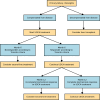Early assessment of treatment response in primary biliary cholangitis: key to timely management
- PMID: 40783513
- PMCID: PMC12335757
- DOI: 10.1186/s12876-025-04138-w
Early assessment of treatment response in primary biliary cholangitis: key to timely management
Abstract
Aim: The aim of our study was to explore predictive factors associated with compete biochemical response (CBR) in primary biliary cholangitis (PBC) patients treated with ursodeoxycholic acid (UDCA) at month 12 and at last check-up; CBR was defined as both normal bilirubin and ALP levels. We also evaluated hepatic decompensation and prognosis during UDCA treatment.
Methods: We conducted a multicenter retrospective study of PBC patients. We enrolled patients with PBC before the beginning of UDCA treatment (13-15 mg/kg body weight per day) between 1999 and 2024 in 2 hepatology centers in Eastern Slovakia.
Results: We enrolled 155 patients in the final analysis, 147 women and 8 men, mean age at diagnosis 57 ± 15 years, the median follow-up was 10 ± 8 years. 29 patients (18.7%) had cirrhosis at diagnosis. Hepatic decompensation occurred in 12 patients during follow-up (7.7%; 95%CI 4-13%). 114 patients (73.5%; 95% CI 66-80%) achieved response to treatment according to Toronto criteria at month 6; CBR after 12 months of treatment was achieved by 41.3% (95% CI 33-50%) of patients; 51 patients (32.9%; 95% CI 26-41%) achieved CBR at last check-up. The OR for achieving CBR at month 12 in Toronto responders at month 6 was 46.36 (95%CI 6.147-349.646); p < 0.001. Of the patients who achieved a response defined by Toronto criteria at month 6, 44.7% of patients achieved CBR at last check-up and 55.3% did not. Out of the patients who did not achieve Toronto at month 6, none achieved CBR at last check-up (0%). Treatment response by Toronto criteria at month 6, CBR at month 12 and absence of liver cirrhosis predicted CBR at last check-up. The odds of decompensation were about 90% lower in patients who achieved treatment response. No case of hepatic decompensation or liver-related mortality during follow-up was observed in patients with CBR at last check-up.
Conclusion: The assessment of treatment response at month 6 is very accurate predictor of complete biochemical response throughout the course of the disease. For non-responders to UDCA treatment, the addition of second line PBC treatment is indicated. For patients who have not met Toronto criteria at month 6 of UDCA treatment, the addition of second line PBC therapy should be considered.
Keywords: Liver decompensation; Primary biliary cholangitis; Prognosis; Second line treatment; Treatment response; Ursodeoxycholic acid.
© 2025. The Author(s).
Conflict of interest statement
Declarations. Ethics and consent to participate: The study protocol is in accordance with the 1964 Helsinki declaration, its later amendments, and the principles of good clinical practice. The study protocol was approved by the Ethical committee of Poprad Hospital, a.s. on 5 May 2019 and by Ethical committee of L Pasteur University Hospital on 22 October 2020. The committee waived the need for the specific patients. informed consent due to the retrospective nature of the data collection. Consent for publication: Not applicable. Competing interests: The authors declare no competing interests.
Figures


Similar articles
-
Pharmacological interventions for primary biliary cholangitis: an attempted network meta-analysis.Cochrane Database Syst Rev. 2017 Mar 28;3(3):CD011648. doi: 10.1002/14651858.CD011648.pub2. Cochrane Database Syst Rev. 2017. PMID: 28350426 Free PMC article.
-
The effectiveness of combining ursodeoxycholic acid with vitamin D in treating patients with primary biliary cholangitis and its impact on hepatic fibrosis: a randomized trial.BMC Gastroenterol. 2025 Jul 18;25(1):525. doi: 10.1186/s12876-025-04118-0. BMC Gastroenterol. 2025. PMID: 40676542 Free PMC article. Clinical Trial.
-
MicroRNA-126-3p as a predictive biomarker for patients with primary biliary cholangitis refractory to ursodeoxycholic acid.World J Gastroenterol. 2025 Aug 21;31(31):109828. doi: 10.3748/wjg.v31.i31.109828. World J Gastroenterol. 2025. PMID: 40901689 Free PMC article.
-
Bezafibrate for primary biliary cirrhosis.Cochrane Database Syst Rev. 2012 Jan 18;1(1):CD009145. doi: 10.1002/14651858.CD009145.pub2. Cochrane Database Syst Rev. 2012. PMID: 22259000 Free PMC article.
-
A Phase 3 Trial of Seladelpar in Primary Biliary Cholangitis.N Engl J Med. 2024 Feb 29;390(9):783-794. doi: 10.1056/NEJMoa2312100. Epub 2024 Feb 21. N Engl J Med. 2024. PMID: 38381664 Clinical Trial.
References
-
- European Association for the Study of the Liver. Electronic address eee, European association for the study of the L: EASL clinical practice guidelines: the diagnosis and management of patients with primary biliary cholangitis. J Hepatol. 2017;67(1):145–72. - PubMed
-
- Lindor KD, Bowlus CL, Boyer J, Levy C, Mayo M. Primary biliary cholangitis: 2021 practice guidance update from the American association for the study of liver diseases. Hepatology. 2022;75(4):1012–3. - PubMed
-
- Granito A, Muratori P, Muratori L, Pappas G, Cassani F, Worthington J, Guidi M, Ferri S, C DEM, Lenzi M, et al. Antinuclear antibodies giving the ‘multiple nuclear dots’ or the ‘rim-like/membranous’ patterns: diagnostic accuracy for primary biliary cirrhosis. Aliment Pharmacol Ther. 2006;24(11–12):1575–83. - PubMed
Publication types
MeSH terms
Substances
LinkOut - more resources
Full Text Sources
Miscellaneous

